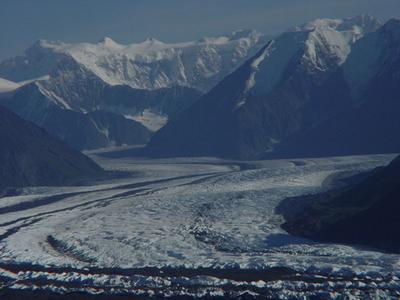3 August, 2002
Greetings......
Today, I helped Tim Alessi, an REU student from the University of Wisconsin
at Oshkosh on his project again. We took sediment samples from two
different kettle lakes the the forest covered area he is studying. The
sediment samples will be analyzed once he gets back to school. He will be
looking for and pollen in the samples. The types of pollen at different
levels in the sediment will reveal information regarding the types of plants
in the area at the time those sediments were deposited.
The sediment samples were collected by driving a 2 inch diameter tube down
through the water of the kettle lakes into the sediment. The top was then
sealed creating a vacuum, which held the sediments as the tube was pulled
out. Once out of the lake, the sediments were pushed out of the tube and
placed on a sheet of aluminum foil to dry.
Dr. Baker returned this afternoon from Anchorage, and we took a hike up
Lionšs Head Rock. It is a large rock outcrop that rises about 1000 ft.
above the glacier. The views from the summit were spectacular and presented
an incredible opportunity for picture taking. I have attached one to prove
my point.
Life Is Good,
DT

Looking in a southeasterly direction from the top of Lion's Head Rock up the Matanuska Glacier. Notice the dark stripes on the clean ice. These are medial moraines caused when the debris along the edges of two smaller glaciers unite as the glaciers flow together.
Contact the TEA in the field at
.
If you cannot connect through your browser, copy the
TEA's e-mail address in the "To:" line of
your favorite e-mail package.
|
